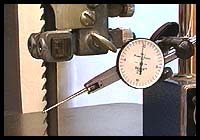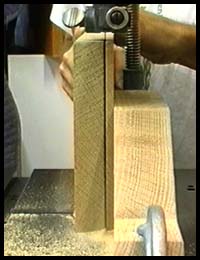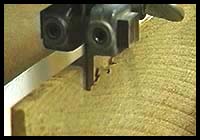

Lenox Pro Master III Bandsaw Blade
- A Tool Review: by Jim Mattson
 Over the years a transformation has
occurred in the attitude woodworkers have for their cutting tools.
Not too long ago we would buy carbon or high-speed steel blades
for everything: sawblades, router bits, planer and jointer knives,
molding cutters, etc. We could either sharpen them ourselves
or toss them out if sharpening wasn't cost effective.
Over the years a transformation has
occurred in the attitude woodworkers have for their cutting tools.
Not too long ago we would buy carbon or high-speed steel blades
for everything: sawblades, router bits, planer and jointer knives,
molding cutters, etc. We could either sharpen them ourselves
or toss them out if sharpening wasn't cost effective.
Then came carbide; little by little it's crept into nearly every facet of woodworking cutting material. As it is now, most of us take it for granted, when we shop for blades and bits, it's going to be carbide. It's the standard and who wants to spend their woodworking hours sharpening? Not me.
One cutting tool which has gone largely overlooked, during this transformation of attitude, is the lowly bandsaw blade. While I would never think of buying a steel-tooth blade for my tablesaw, it's been usual for me to plop down $50 dollars for a six-pack of cheap bandsaw blades knowing full well half of them won't last a year. But I'll hold onto them much longer than I should 'cause $50 is a lot of money.
Not any more. After my less-than-stellar review of bandsaw bearing guides, Louis Iturra of Iturra Design sent me something he was sure I was going to love - a Lenox Pro Master III carbide-tipped bandsaw blade for my Delta 14" saw.
Louis was right. Over the intervening months, the Pro Master received exclusive use on my bandsaw dicing up 16/4 poplar timbers, resawing walnut and I even milled a couple dogwood logs into lumber, not to mention all the other less taxing shop duties. Through all, the Pro Master III handled everything with ease so I decided to up the ante a bit. I had some really nasty 5/4 white oak slabs laying around the shop I wanted to resaw for some curved chair backs. Here is the rest of the scoop.
 Initial
Impressions
Initial
Impressions
The Pro Master III is a 3 TPI, equally spaced, triple-chip grind
bandsaw blade. The carbide teeth are welded to the .025"
band and the resulting kerf is less than 1/16". (.056").
The blade comes in a standard bubble pack with the teeth wrapped
in a nice vinyl cover. Unfortunately I couldn't figure out how
to get the cover back on after removing it without serious risk
of getting nicked by the blade's sharp teeth. Plan on hanging
your Pro Master unfolded out of the way when you have other blades
Installed.
On the up side, mounting the 1/2" blade was pretty straight forward. Even though the band is a bit thicker than your average bandsaw blade, I had no trouble getting it tracking smoothly on my saw. Also, testing with the dial indicator revealed a very consistent sharpening job by Lenox. I was impressed.
 Resawing
White Oak
Resawing
White Oak
My Delta is the standard version and not equipped with the 6"
riser block some woodworkers buy to resaw 12" wide lumber.
This has suited me fine because up until now I've never really
considered this 3/4 horsepower saw suitable for such optimistic
hardwood sawing.
The regular alloy blades I've bought over the years, some more expensive like the Woodslicer from Highland Hardware, have worked well for a little while but they dulled too quickly and it seemed about 4" wide was the maximum practical width for this application. If I wanted to resaw wider stock, a friend has a Makita Resaw with stellite-tipped blades and I would just run over there to mess up his shop instead.
BTW, stellite is where they impregnate the teeth with carbide and my friend's blades cost about $65 each. They do last longer than hardened steel blades but my friend is collecting his own batch of resaw blades too dull to work with at maximum capacity.
To really test the Pro Master III, I prepared nine white oak boards 6" wide and about 2' long. The fence was set up to give me four 1/4" thick pieces from each blank. As mentioned before, the Pro Master had already sliced up several hundred feet of 4"+ poplar, walnut and dogwood and the cutting edge showed no signs of dulling. The 3/4 HP motor drove this blade fairly easily without any hint of bogging down.
During a recent conversation with Louis Iturra I asked about getting the Pro Master re-sharpened. He said there is no procedure in place for doing so and it's his understanding from Lenox the blade will break before needing a new edge. It would seem the constant flexing of thousands of trips around the Delta's bandsaw wheels is the Achilles heal for this blade. Releasing the tension after sawing sessions doesn't seem to help prolong the band's life and metal fatigue will be it's eventual downfall. Until that happens, let's slice up some oak.
 Cutting
Straight
Cutting
Straight
One of the first things you notice about this blade is how well
it cuts where you tell it to - very obedient! It seemed no matter
what type of cut I made, straight or curved, the teeth plowed
through the wood in a straight line from top to bottom. There
was no wavering to follow the grain or any other paths of least
resistance. Regular blades will do the same thing when they're
new but this has always been the first harbinger of impending
uselessness.
With the Pro Master, even when dipping into and out of a cut, it seemed impervious to deflection. This should be of particular value to turners who routinely use a bandsaw for roughing out gnarly bowl blanks. I found it could cut circles as small as 3 1/2" diameter making it very versatile for most any type of curved cutting. On the downside, because the blank is so much thinner than the teeth, any hiccups in your motion are apt to create sideways digs in the cut which are difficult to remove with sanding. Don't look to this blade for smooth scrolling unless you're pure of heart and extremely steady of hand.
 Cutting
Smooth
Cutting
Smooth
While we're on the subject, this blade is advertised to leave
a smoother finish than other blades. I found this only partly
true. For woods having a uniform density like maple and poplar,
it did seem to leave a smoother surface. When I got into the
oak, the Pro Master left a finish typical of course resaw blades.
I believe the reason came from the amount and type of dust clogging the gullets of the blade and possibly shoving the teeth slightly sideways in the cut. When I slowed the feed rate down to about 1' per 20 seconds, the surface came out less rough but this rate seemed too slow for how aggressively this blade wanted to run.
What I really liked was the flatness of the cut. Anyone who has done much resawing with regular blades knows how they like to wander as they get dull. With the Pro Master, each piece was so flat I didn't head back to the jointer after each cut - what a time saver! For my project, it seemed easy to just run the 1/4" thick pieces through the planer, one pass on each side, leaving a 3/16" finished thickness. Besides, who really counts on a finished surface from a bandsaw cut? Come on!
 Slicing
Veneer
Slicing
Veneer
I had a few pieces left over and just for kicks, I thought I'd
like to make some veneer. We've all drooled over pictures in
magazines or woodworking books where the author has cut a perfectly
even, thin piece of wood with a bandsaw. What they never tell
us is how many they can produce this way before tossing the blade.
Every time I try it, my results are less than satisfactory. When
I see these pictures I invariably say to myself, 'Yeah...right.'
The Pro Master has changed all that. With only a 4" tall fence and a puny featherboard to hold the parts in place, I decided to resaw four of my 1/4" pieces. That's right, split them in half. Because of my somewhat negligent setup, the veneers weren't as uniform as I would have liked and the stock did jump a bit from lack of mass. Still, after splitting the thin pieces, I could only smile, smile, smile.
 As you can see from the photo at right, the eight 3/32"
pieces came out pretty good. Certainly this opens up new possibilities
I haven't considered before. Since it's highly problematic to
get veneers to color-match with solids on a mixed material project,
using the Pro Master means you could conceivably take a few boards
milled from the same log and cut your own veneer. Plus, the veneer
can be any thickness you want lending some real durability to
large surfaces. Instead of 1/50" thickness, how about 1/16".
I love it!
As you can see from the photo at right, the eight 3/32"
pieces came out pretty good. Certainly this opens up new possibilities
I haven't considered before. Since it's highly problematic to
get veneers to color-match with solids on a mixed material project,
using the Pro Master means you could conceivably take a few boards
milled from the same log and cut your own veneer. Plus, the veneer
can be any thickness you want lending some real durability to
large surfaces. Instead of 1/50" thickness, how about 1/16".
I love it!
If I were to approach such a project this way, I'd improve the setup in the following areas: first I would raise the fence to the height of the desired veneer, making sure it was parallel to the blade. As easily as this sawblade cut 6" oak, twelve inches with a riser block seems entirely possible. Then I would try to devise some sort of tall featherboard or even a vacuum attachment to keep the stock firmly against the fence. Finally, I wouldn't try splitting a bunch of narrow pieces but start from scratch with a thicker board, taking off each veneer from one face and running back to the jointer only when absolutely necessary.
To apply the veneer to a plywood or MDF substrate, my choice would be to use a vacuum press with a thin melamine platen, seaming the veneer as you would any other and not worrying about surface smoothness against the glue. I'm sure a little extra Tightbond will hold the wood down just fine. Of course, if you have a wide-belt or drum sander, you can surface your pieces before assembly. I don't have such a beast and instead, would surface the veneered panels afterwards, either by hand, through the planer or by renting time on a wide-belt sander. If you aren't bookmatching your parts, you can take a jointer pass between cuts with the Pro Master and then laminate the smooth side out. To each his own...:)
Recommendations
If your bandsaw collects more dust than it makes, skip the Pro
Master III - it isn't worth the extra money.
If you rarely cut wood thicker than 2" or you have a bandsaw with really tiny wheels (which might hasten the band's metal fatigue) buying such a blade might not be cost effective.
If you like using your bandsaw and want to explore the world of resawing and veneer making, the Pro Master could be a valuable addition to your shop.
If you are like me and you're frustrated by the short cutting lives of regular blades, especially if you cut exotics like teak and ebony, and you're tired of messing with them when they start to dull, you really need this blade. It will do for you what carbide has done for the other tools in your shop. If mine lasts five years at my current level of usage, I'll be perfectly happy. If it only lasts a year because it's opened up so many new possibilities and I just can't stay away from my bandsaw, that's OK too. Fortunately this is a webpage and if breaks next week I can add such consequence to the review.
I can say one thing for sure - when it does eventually break, and if it doesn't seem pre-mature, I'm going for the longer blade and the riser kit for my saw. Twelve-inch wide veneers... here I come!
Availability as of 2010
Unfortunately I've lost contact information with Louis Iturra so I can't say whether he's still in business or not. As to other suppliers and prices, you're on your own. Let me know if you have any success.
Jim Mattson
Article Update: May 20th,
2001
Since uploading this review, I've received several emails from
potential and current Lenox owners. Only one person expressed
any dissatisfaction with the Pro Master and since he didn't answer
my email, I'm wondering if his complaints were legitimate.
As for those who have responded to my questions about the Lenox, one email exchange between me and Jim Marco was particularly informative. Here are his thoughts on this bandsaw blade:
*******************
Jim,
The Lenox blade is good. It has now outlasted a couple regular
blades and still cutting. The kerf is a bit heavier than the
steel blades, but the edge is better. It does not do as well
as a new steel blade. But, the newness on a steel blade only
lasts about 15-30 minutes. The Lenox shines here since it appears
to always cut about the same, even after 2 hours of resaw work.
The consistency of the cuts is nice. The same pressure, the same allowance for "lean" (very little on the Lenox), the same cutting action and response to knots and burled grains. Very comfortable knowing what to expect: before turning on the saw, in the cuts and between different woods. The blade responds consistently, with only the wood thickness and hardness changing sawing conditions and feel of the cut. Great!
My 2hp motor is a bit taxed. It resaws 6" OK. The wider 10-12" boards are slow going. Again, a 1hp motor with a new steel blade did about the same as the Lenox with the 2hp motor.
I have not tried tweaking the blade speeds. In the past, I have found that speed changes of 15-25% have made quite a difference in the ease of cuts. I suspect that the low speed setting (chosen for a little extra power on the blade) may be limiting the cut as much as the slightly greater kerf the blade is cutting... higher speed may let the blade cut easier. Again, this is my gut feel for the blade, and, I have not gotten around to trying it. (The veg garden and wife's flowers have had precedence in my shop for the past three weeks.) Soo, my initial evaluation may be considered as a "worst case".
Overall, an excellent value. I managed to get the Lenox for $86. So, it has outlasted 2-3 blades so far, and still cutting...well on it's way to being a sound investment. The time saved in setting up a new blade, is a great relief. I just use the saw these days. It seemed that I was always thinking of new blades and set-ups. I tolerated minor alignment problems, knowing that a new blade was not far off. I spent extra time getting the Lenox blade set-up in the saw as nearly perfect as I could manage...it STAYS that way. Wow! Again, the consistency is a big plus to me. I agree with the items in your review, except, it does leave a little coarser cut than some of the finer steel blades. Again, overall, it is probably the best blend of features in a general purpose blade. Some specialty blades could beat it in specific instances, but not as a general utility blade. I even cut some aluminum bar stock for some jigs with no ill effects. (The aluminum will cake-up on some blades very quickly. The Lenox did not do this for the pieces I cut.)
Thanks again for the excellent
review steering me in this direction.
jdm
*****************
If you have any comments on this blade you want included with this review, send me an email, OK?